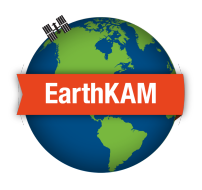Sally Ride EarthKAM

Sally Ride EarthKAM (Earth Kknowledge Acquired by Middle school students) is a NASA educational outreach program started in 1996. The program, initiated by Dr. Sally Ride, the first American woman in space, allows students to direct a digital camera aboard the International Space Station (ISS) to take photographs of specific places on Earth.[1]
During Sally Ride EarthKAM missions (periods when the Sally Ride EarthKAM camera is operational), middle school students around the world can submit requests to capture photographs of specific locations. There are typically four missions a year. Students’ requests are relayed to a camera on the ISS. The camera snaps photographs of the designated locations, and the digitized images are transmitted from orbit through a TDRSS Ku band satellite link to Johnson Space Center Mission Control. The images ultimately are posted on the Sally Ride EarthKAM website, where students can view and study them.[1][2]
The project is run cooperatively by the University of California, San Diego; Sally Ride Science; Johnson Space Center; and the Jet Propulsion Laboratory (JPL).[3]
Since the program’s creation, cameras aboard the space shuttle and later the ISS have taken thousands of photographs of Earth. The entire collection of Sally Ride EarthKAM images is available in a searchable Sally Ride EarthKAM image archive. [1]
To take part in the program, teachers sign up on the Sally Ride EarthKAM website and then receive code words that are used to track image requests. [1]
History
Sally Ride had the idea for the program and worked with NASA to implement it in 1996. Originally called KidSat, the program allowed middle school students to capture images of Earth using a camera aboard the space shuttle. The program operated during five shuttle flights (STS-76, STS-81, STS-86, STS-89, and STS-99).
KidSat was renamed EarthKAM (Earth Knowledge Acquired by Middle school students) in 1998. In 2001, the camera moved to the International Space Station, and the program was renamed ISS EarthKAM.[3] After Ride's death in 2012, NASA renamed the program Sally Ride EarthKAM in her honor.[4]
EarthKAM captured the first photo of Earth from the newly installed Window Observational Research Facility (WORF).[5]
Sally Ride EarthKAM received the Top Results Award at the Third Annual International Space Station Research and Development Conference, held June 17-19, 2014.[6]
Past Shuttle and ISS missions
- STS-76, as KidSat
- STS-81, as KidSat
- STS-86, as KidSat
- STS-89, as EarthKAM
- STS-93, as EarthKAM
- STS-99, as EarthKAM
- See also list of missions
See also
- Windows on Earth, a project offering simulated views of Earth from the ISS
- Grail MoonKAM, a related lunar imagery project coordinated by Sally Ride Science
References
- ^ a b c d "About Sally Ride EarthKAM". Sally Ride EarthKAM. Retrieved 21 April 2015.
- ^ DeNisco, Alison. "Students explore space with satellite photography". District Administration. Retrieved 1 May 2015.
- ^ a b "Sally Ride EarthKAM Partners". Sally Ride EarthKAM. Retrieved 21 April 2015.
- ^ "Sally Ride EarthKAM to Receive Award at the International Space Station Conference". Sally Ride Science. Retrieved 21 April 2015.
- ^ "WORF First Image Web Feature". NASA. Retrieved 21 April 2015.
- ^ Weaver, David. "NASA and The White House Pay Tribute to Sally Ride". NASA. Retrieved 21 April 2015.
